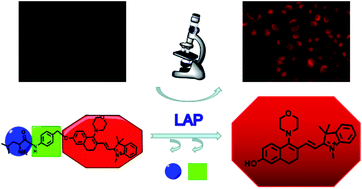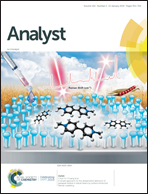A near-infrared fluorescent probe for monitoring leucine aminopeptidase in living cells†
Abstract
Leucine aminopeptidase (LAP), one of the important cancer-related biomarkers, is significantly over-expressed in many malignant tumor cells. Developing an effective fluorescent probe for high-specificity and in situ trapping of endogenous LAP in living samples is still challenging. In this project, we report a water-soluble near-infrared (NIR) fluorescent probe (CHMC-M-Leu) for specific monitoring of LAP in vitro and in vivo. The novel fluorescent probe (CHMC-M-Leu) contains a NIR-emitting fluorophore (CHMC-M) as the reporter and L-leucine as the enzyme-active trigger moiety which are linked together by a p-aminobenzyl alcohol (PABA) section. Upon exposure to LAP, the fluorescence at 625 nm gets impressively enhanced, which belongs to the near-infrared region and is beneficial for imaging in vivo. Furthermore, the novel fluorescent probe exhibits fast response and highly chemoselective detection of LAP in various bio-related species. In addition, CHMC-M-Leu shows favourable cellular uptake and was successfully used to monitor endogenous LAP in living cells.



 Please wait while we load your content...
Please wait while we load your content...